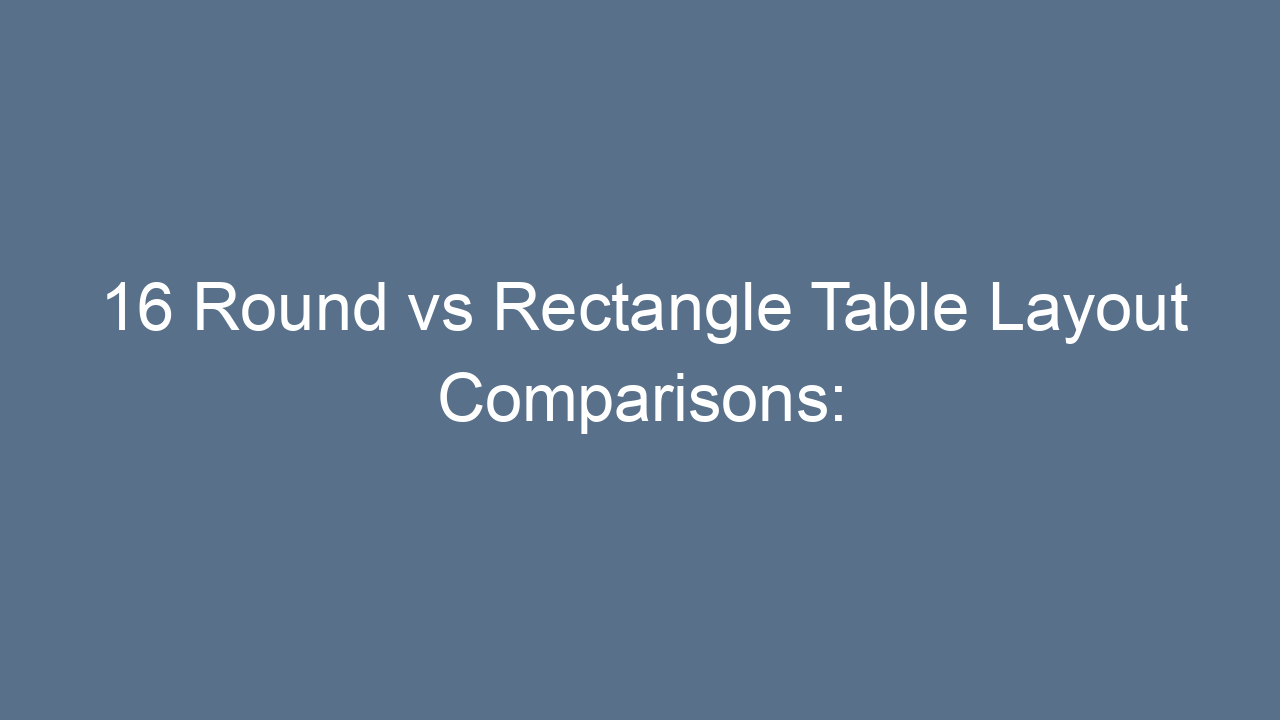16 Round vs Rectangle Table Layout Comparisons: Choosing the Right Style for Your Space

When it comes to round vs rectangle table layouts, most people don’t realize how big a difference shape makes. A table is more than a piece of furniture—it sets the tone for how people connect, share meals, and feel in a room. Whether you’re designing a dining area, a cozy breakfast nook, or even a workspace, the shape of your table influences both function and feeling.
A round table creates intimacy, while a rectangle table provides structure. Each has strengths, but the best choice depends on your space, lifestyle, and personal taste. In this guide, I’ll walk you through 16 comparisons between round vs rectangle tables, offering real insights, personal reflections, and cultural nuances that make the topic feel relatable. By the end, you’ll have a clear picture of which table shape fits your world.
In This Article
- 1 1. Space Efficiency: Fitting Shape into Small or Large Rooms
- 2 2. Seating Capacity: Maximizing How Many People Fit
- 3 3. Social Interaction: Encouraging Conversation
- 4 4. Formal vs Casual Atmosphere
- 5 5. Safety Concerns: Sharp Edges vs Smooth Curves
- 6 6. Table Placement: Centered vs Aligned with Walls
- 7 7. Flexibility for Extensions
- 8 8. Style and Aesthetic Impact
- 9 9. Cultural Influences and Traditions
- 10 10. Dining Flow: Serving and Passing Dishes
- 11 11. Table Size vs Room Size Balance
- 12 12. Versatility Beyond Dining
- 13 13. Lighting Considerations
- 14 14. Storage and Chair Placement
- 15 15. Psychological Impact: Energy and Flow
- 16 16. Budget and Availability
- 17 Final Thoughts
1. Space Efficiency: Fitting Shape into Small or Large Rooms
If you’ve ever tried to squeeze a rectangle table into a small apartment, you know the struggle. Corners jut out awkwardly, and the whole setup can feel rigid. A round table, on the other hand, naturally saves space. Its lack of sharp edges makes it easier to navigate around in compact rooms. This is why round tables are common in small kitchens or breakfast nooks.
In bigger spaces, rectangle tables often work better because they can stretch to fill the room. A long rectangular dining table can anchor a large dining area beautifully. So if your space is narrow and tight, round wins. But if your room is long and wide, rectangle feels balanced.
2. Seating Capacity: Maximizing How Many People Fit
When it comes to how many chairs you can fit, rectangle tables usually hold more people. You can line chairs along the sides and add a couple at the ends. This makes it ideal for big families or hosting parties.
But round tables shine when you want flexible seating. You can usually squeeze in an extra chair without it looking awkward. A round table feels more forgiving when the guest count changes last minute. It’s like a circle of friends that keeps expanding. So the choice depends on whether you prioritize numbers or adaptability.
3. Social Interaction: Encouraging Conversation
Here’s where round tables really win. Think about it—when everyone sits in a circle, no one is left out. You can make eye contact with everyone easily. That’s why round tables are often chosen for family meals, brainstorming sessions, or gatherings where connection matters.
Rectangle tables sometimes create a divide. People at opposite ends might feel too far away to chat. Conversations often happen in clusters rather than as a whole group. But if you enjoy smaller side conversations or like having a “head of the table,” rectangle shapes suit that vibe better.
4. Formal vs Casual Atmosphere
A rectangle table has an inherent formality. There’s usually a clear “head” position, making it perfect for formal dinners, meetings, or occasions where hierarchy is present. It creates structure, almost like a stage where roles are defined.
By contrast, round tables feel casual and relaxed. They erase hierarchy and invite equal participation. There’s no “important seat” because every seat matters. This makes them great for cozy dinners with friends or family gatherings where you want warmth over formality.
5. Safety Concerns: Sharp Edges vs Smooth Curves
If you’ve ever bumped your hip against the corner of a rectangle table, you know the pain. Families with kids often prefer round tables because the smooth edges reduce accidents. Even in small apartments, you move around more easily without worrying about corners.
That said, modern rectangle tables with rounded edges can reduce the issue. Still, if safety is a top priority—especially with toddlers or in tight layouts—round edges feel like a blessing.
6. Table Placement: Centered vs Aligned with Walls
Round tables usually look best when placed in the center of a room. They demand attention and create symmetry. That’s why you’ll often see round tables under chandeliers, making them the star of the space.
Rectangle tables, however, align better with walls or long room layouts. They can run parallel to architecture like windows, cabinets, or rugs. If your room has clear lines, a rectangle table feels more natural. If your room is open and airy, a round table shines better.
7. Flexibility for Extensions
When it comes to extensions, rectangle tables usually win. Many come with built-in leaves that let you expand the table for guests. This makes them adaptable for both everyday use and big dinners.
Round tables, while extendable, often lose their pure circular shape when extended. They may turn into an oval, which still works but feels less symmetrical. If you often need more space, rectangle designs may give you more functional flexibility.
8. Style and Aesthetic Impact
A round table feels softer and more approachable. It adds curves to a room, balancing out angular walls and furniture. It works beautifully in spaces aiming for warmth, elegance, or even a romantic feel.
On the other hand, rectangle tables look bold and structured. They suit modern, minimalist, or formal interiors. A long wooden rectangle table in a dining hall creates a statement of power and tradition. The style choice often depends on whether you lean towards soft warmth or bold authority.
9. Cultural Influences and Traditions
Culture plays a huge role in table choices. In many Asian cultures, round tables symbolize equality and unity. Think of Chinese banquet halls where lazy Susans spin at the center, ensuring everyone shares equally.
In Western traditions, rectangle tables dominate, especially in formal dining rooms. The long table signifies structure and sometimes hierarchy, where the host sits at the head. Understanding cultural context can help you choose a shape that resonates with your values and traditions.
10. Dining Flow: Serving and Passing Dishes
When you eat at a round table, passing dishes is smoother. The circle shape ensures food reaches everyone quickly. If you’ve eaten hotpot or shared dishes, you’ll know how convenient it feels.
In contrast, rectangle tables can make passing harder. People at the far end might wait longer for dishes. But with buffet-style meals, rectangle layouts feel more efficient, as people can serve themselves along the sides.
11. Table Size vs Room Size Balance
A small round table in a tiny room feels cozy, while a large round table in a small room feels overwhelming. The same goes for rectangles—a long table in a narrow dining room can make the space feel cramped.
The trick is proportion. Round tables fit square rooms better, while rectangle tables match rectangular rooms. This simple rule of thumb makes decorating less stressful and ensures balance.
12. Versatility Beyond Dining
Rectangle tables are multi-functional. They can double as work desks, craft tables, or study spaces. Their flat, extended surface makes them practical beyond meals.
Round tables, however, excel in social or leisure activities. Card games, conversations, and collaborative projects feel more engaging around a circle. So if your table often doubles as an office, rectangle might suit you better. If it’s about togetherness, round wins.
13. Lighting Considerations
A round table pairs beautifully with a single pendant light or chandelier centered above it. The symmetry makes the room feel balanced.
With rectangle tables, you often need multiple lights or a long fixture to illuminate the entire surface evenly. While it adds drama, it can also require more planning. Lighting becomes a subtle but important factor in your decision.
14. Storage and Chair Placement
Chairs tuck more neatly under rectangle tables, especially when the table legs are at the corners. This keeps the room looking tidy.
Round tables sometimes have pedestal bases, which free up leg space but can limit how chairs fit around them. It’s not a huge issue, but worth considering if you value neatness and organization.
15. Psychological Impact: Energy and Flow
Shapes carry energy. A circle feels endless and inclusive, symbolizing unity. People often describe round tables as calming and friendly.
A rectangle carries direction and purpose. It suggests movement and focus, which is why it often appears in workplaces or formal dining settings. If you’re sensitive to atmosphere, you might choose based on how you want people to feel in the room.
16. Budget and Availability
Finally, let’s talk cost. Rectangle tables are more common, so you’ll usually find more options at different price ranges. They’re also easier to match with standard chairs and furniture.
Round tables can be pricier, especially in larger sizes. Custom options may cost more since they’re less mass-produced. Still, investing in one can be worthwhile if you want a standout piece.
Final Thoughts
Choosing between a round vs rectangle table layout isn’t about one being better than the other. It’s about harmony—matching the table to your space, your lifestyle, and even your personality. A round table whispers intimacy and equality, while a rectangle table speaks structure and power.
The beauty lies in aligning your choice with your values. Do you want warmth and togetherness, or formality and direction? Think about your room’s proportions, your family’s habits, and the way you want conversations to flow. Once you connect those dots, the right table shape will reveal itself naturally—almost like it was always meant to be there.






